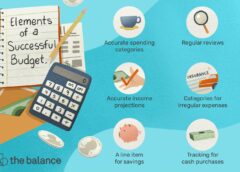
Creating a budget is one of the most effective ways to take control of your finances, achieve your financial goals, and ensure long-term financial stability. In this article, we’ll explore what a budget is, why it’s important, and how you can create one tailored to your needs.
What is a Budget?
A budget is a financial plan that outlines your expected income and expenses over a specific period, typically a month. It helps you track where your money is coming from and where it is going. By having a clear picture of your finances, you can make informed decisions about saving, spending, and investing.
Why is a Budget Important?
- Financial Control: A budget helps you gain control over your finances by providing a clear overview of your income and expenses.
- Goal Achievement: It allows you to set and prioritize financial goals, whether it’s saving for a vacation, buying a home, or paying off debt.
- Debt Reduction: With a budget, you can allocate funds towards paying off debt more effectively.
- Savings Growth: By tracking expenses, you can identify areas where you can cut back and increase your savings.
- Stress Reduction: Knowing your financial situation reduces stress and uncertainty, leading to better financial decisions.
Steps to Create a Budget
Creating a budget involves a few key steps. Let’s break it down:
- Determine Your Income
Start by calculating your total monthly income. This includes:
- Salary or wages
- Freelance or side gig earnings
- Rental income
- Any other sources of regular income
Ensure you use your net income (after taxes and deductions) for an accurate picture.
- Track Your Expenses
Next, list all your monthly expenses. Categorize them into two main groups: fixed and variable expenses.
- Fixed Expenses: These are regular, unchanging expenses such as rent/mortgage, utilities, insurance, loan payments, and subscriptions.
- Variable Expenses: These fluctuate monthly and include groceries, dining out, entertainment, transportation, and miscellaneous spending.
- Set Financial Goals
Identify your short-term and long-term financial goals. Examples include:
- Building an emergency fund
- Saving for a down payment on a house
- Paying off credit card debt
- Planning for retirement
Assign a priority to each goal to help you focus on what’s most important.
- Create a Plan
Based on your income and expenses, create a plan that aligns with your financial goals. Allocate specific amounts for savings, debt repayment, and discretionary spending. Here’s a simple approach:
- 50/30/20 Rule:
- 50% for needs (rent, utilities, groceries)
- 30% for wants (entertainment, dining out)
- 20% for savings and debt repayment
Adjust these percentages based on your personal situation.
- 50/30/20 Rule:
- Monitor and Adjust
Regularly review your budget to ensure you’re on track. Adjust as necessary based on changes in income or unexpected expenses. Use budgeting tools or apps to make tracking easier.
Tips for Successful Budgeting
- Be Realistic: Set achievable goals and realistic spending limits.
- Automate Savings: Set up automatic transfers to your savings account.
- Track Every Penny: Keep a detailed record of all expenses, no matter how small.
- Review Monthly: Regularly review your budget to identify patterns and make adjustments.
- Stay Flexible: Life is unpredictable; be prepared to adapt your budget as needed.
Conclusion
Creating and sticking to a budget is essential for financial health and achieving your financial goals. By understanding your income and expenses, setting clear goals, and regularly monitoring your progress, you can take control of your finances and build a secure financial future. Start today, and experience the peace of mind that comes with being financially organized and prepared.


